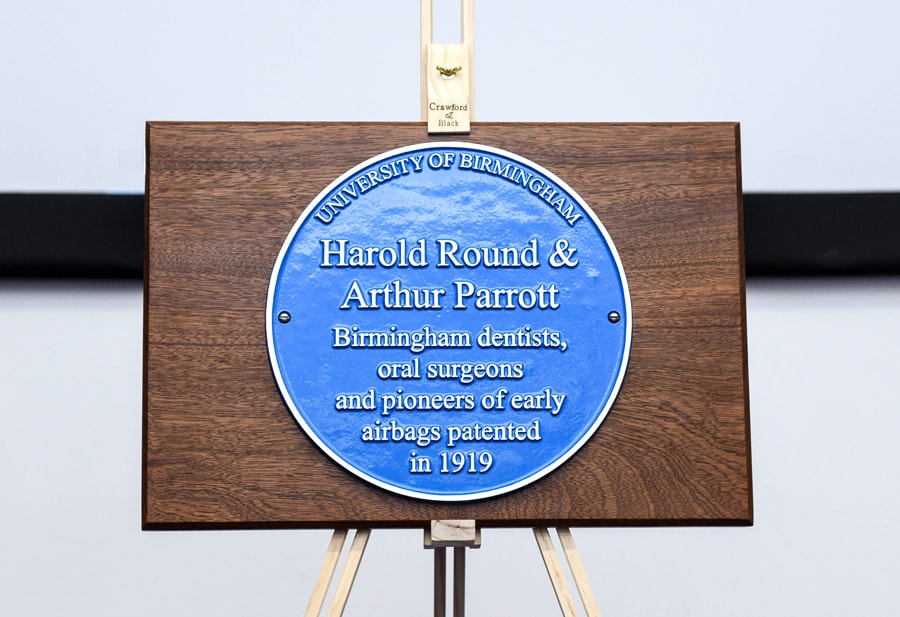
A new ‘blue plaque’ is set to be unveiled as part of the University of Birmingham's history trail which will celebrate the work of two innovative dentists whose inventions have saved thousands of lives.
The plaque pays homage to University of Birmingham alumnus Harold Round and his colleague Arthur Parrott, who were both instrumental in developing an early version of the airbag to prevent impact jaw fractures during the First World War.
This year marks 100 years since they filed the patent for the airbag and, to mark the occasion, the blue plaque will be unveiled at a special event at the University’s School of Dentistry on Monday, March 18th. The event, which is open to the public, will both showcase Round and Parrott’s work, while it will also feature other University of Birmingham innovations in dentistry.
The event will include lunch and a presentation on the history of dentistry by Jonathan Reinarz, University of Birmingham Professor of the History of Medicine. There will be an opportunity to view some historical dental instruments and experience first-hand how challenging dentistry has been across the ages.
There will also be an optional tour of Birmingham Dental Hospital and School of Dentistry to view the state of the art facility.
Professor Iain Chapple, Head of the University of Birmingham’s School of Dentistry, said: “Since its earliest days, the University of Birmingham has been a home to innovative pioneers who have effected change in the world we live.
“The University’s Blue Plaque Trail, modelled on schemes adopted in many British cities, celebrates their ground-breaking achievements and we are delighted that two such accomplished pioneers in dentistry will now be honoured as part of this trail.
“We hope this latest blue plaque will inspire those who pass by and will encourage continued innovation and achievement in the future.”
The blue plaques around the campus serve as reminders of the immense accomplishments of the men and women who have worked at the University.
Since it received its Royal Charter in 1900, the University of Birmingham has been responsible for an immense number of innovations, inventions and breakthroughs, including the creation of the Cavity Magnetron which made possible both radar and microwave ovens and changed the world as we knew it.
The feasibility of the atomic bomb, secrets of particle physics, mathematical analysis of Bessel functions, and the mass of the Earth were all discovered at the University, while the work of the University’s geologists has helped us to understand climate change and the formation of mountain belts.
Health and life expectancy throughout the world has been improved through the work of the University of Birmingham, with developments such as the variable-rate heart pacemaker, pioneering experiments in skin grafting, and the synthesis of Vitamin C.
Social policy improvement, investigation into economic reform and innovative town planning involving individuals such as Margery Fry, Sir William Ashley, Francois Lafitte and John Sutton Nettlefold have also greatly enhanced the quality of life worldwide.
Composers, musicians and writers including Sir Edward Elgar, Louis MacNeice and David Lodge, have taught at the University of Birmingham, while Sir Granville Bantock helped found the City of Birmingham Symphony Orchestra.
The general public must register in advance if they wish to attend the unveiling of the blue plaque on March 18th 2019.
For more information contact Emma McKinney, Communications Manager (Health Sciences), University of Birmingham, or call +44 (0) 121 414 6681, or contact the press office out of hours on +44 (0) 7789 921 165.
- The University of Birmingham is ranked amongst the world’s top 100 institutions. Its work brings people from across the world to Birmingham, including researchers, teachers and more than 6,500 international students from over 150 countries.
- The School of Dentistry is ranked 13th in the world QS University rankings 2019, largely based upon its research.
- Find out more Information on the University of Birmingham history trail web page.